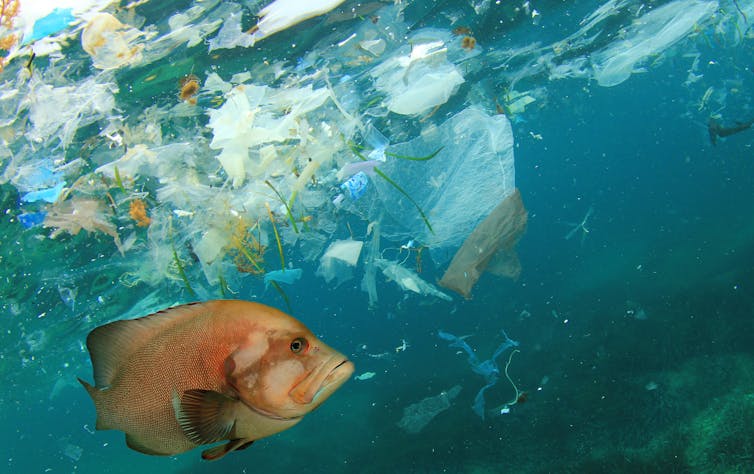
Microplastics (MP) have become a widespread environmental contaminant infiltrating various ecosystems, including aquatic environments. Aquaculture, as a major source of fish and seafood production, is not immune to the impact of microplastic contamination.
A team of researchers from the University of Kerala (India) analyzed ten widely used commercial fish feeds in aquaculture across six countries on three continents to assess microplastic (MP) contamination.
Microplastics in Aquaculture Feeds
Microplastics (MP), small plastic particles less than 5 millimeters in size, have become a widespread environmental contaminant. These particles can enter aquaculture systems through various pathways, including contaminated water sources, plastic debris from fishing gear, and the use of fishmeal and fish oil in feeds.
Fishmeal and fish oil, essential ingredients in aquaculture feeds, are often derived from marine resources that may contain microplastics. The processing and handling of these raw materials can also introduce additional MPs into the feed. Studies have shown that commercial fish feeds can contain significant amounts of microplastics, which may be ingested by farmed fish.
Health Risks Associated with Microplastic Ingestion
The ingestion of microplastics by fish can have negative health consequences. Microplastics can accumulate in fish tissues and may interfere with their digestive, respiratory, and reproductive systems. Additionally, microplastics can act as vectors for harmful chemicals, such as heavy metals and pollutants, which can bioaccumulate in fish and ultimately enter the human food chain.
The Research
The researchers analyzed ten commercial fish feeds from six countries to assess MP contamination. The feeds underwent a filtration process to extract MPs, which were then characterized using Fourier-transform infrared spectroscopy (FTIR) and scanning electron microscopy-energy dispersive X-ray spectroscopy (SEM-EDX). The abundance and types of MPs, as well as the presence of heavy metals, were determined.
Analysis of Microplastic Contamination in Fish Feeds
A recent study analyzed ten widely used commercial fish feeds across six countries on three continents to assess their microplastic content. The results were alarming. On average, these feeds contained 1,130 microplastic particles per kilogram, with fibers being the most common type (85%), followed by fragments (15%). Most of these microplastics were black in color.
Stay Always Informed
Join our communities to instantly receive the most important news, reports, and analysis from the aquaculture industry.
The abundance of microplastics varied among the different feed samples. SP feed contained the highest concentration of microplastics (26%), while HCF had the lowest (3%). The identified polymers included polyethylene terephthalate (PET), polyamide (PA), polymethyl methacrylate (PMMA), polyurethane (PU), polystyrene (PS), and polypropylene (PP).
Microscopic examination of the fibers revealed surface imperfections such as scales, cracks, and pits. Additionally, heavy metals, including nickel, copper, zinc, chromium, gold, mercury, cadmium, titanium, and lead, were detected on the surface of these fibers. Some fragments also contained niobium, a less common element.
Polymer Hazard Index (PHI)
To assess the potential harm of these microplastics, the researchers calculated the Polymer Hazard Index (PHI) for each feed. A PHI value of 400 or higher indicates a highly dangerous level. Nine out of the ten feeds analyzed fell into this category, with PHI values ranging from 400 to 394,825.
Implications for Aquaculture
The results of this study highlight the significant risk posed by microplastic contamination in aquaculture feeds. These tiny particles can be ingested by fish, potentially leading to adverse health effects. Moreover, as these fish enter the food chain, microplastics may reach human consumers.
To mitigate the risks posed by microplastic contamination, it is essential to implement effective measures to reduce their presence in aquaculture feeds. This includes:
- Improving feed sourcing practices: Ensuring that fishmeal and other feed ingredients are sourced from sustainable and microplastic-free sources.
- Enhancing feed processing and handling: Adopting hygienic practices to minimize the introduction of microplastics during feed production and storage.
- Developing innovative feed formulations: Exploring alternative ingredients and technologies to reduce dependence on fishmeal and minimize microplastic contamination.
- Strengthening regulations and standards: Implementing stricter regulations to control plastic use in aquaculture and ensure the safety of aquaculture products.
Conclusion
The study provides compelling evidence of the prevalence of microplastic contamination in commercial fish feeds. The findings underscore the urgent need for effective measures to reduce MP contamination in aquaculture. Strategies to mitigate MP contamination in feeds may include using alternative packaging materials, improved manufacturing practices, and developing MP-free feed ingredients.
By addressing this issue, we can contribute to the sustainability of aquaculture and protect the health of our fish, aquatic ecosystems, and consumers of aquaculture products.
The study was conducted as part of the Project ECOMARINE (Building a Comprehensive Mechanism for Preserving Marine Ecosystems and Life from the Negative Consequences of Climate Change and the Disposal of Plastic Debris), funded by the European Union’s Erasmus program.
Contact
Appukuttannair Biju Kumar
Department of Aquatic Biology and Fisheries, University of Kerala
Thiruvananthapuram 69551, Kerala, India.
Email: bijukumar@keralauniversity.ac.in
Reference
Devi, S. S., Jayan, S., & Kumar, A. B. (2024). Microplastic assessment in aquaculture feeds: Analyzing polymer variability across commercial fishfeeds from three continents. Journal of Hazardous Materials, 135621. https://doi.org/10.1016/j.jhazmat.2024.135621
Editor at the digital magazine AquaHoy. He holds a degree in Aquaculture Biology from the National University of Santa (UNS) and a Master’s degree in Science and Innovation Management from the Polytechnic University of Valencia, with postgraduate diplomas in Business Innovation and Innovation Management. He possesses extensive experience in the aquaculture and fisheries sector, having led the Fisheries Innovation Unit of the National Program for Innovation in Fisheries and Aquaculture (PNIPA). He has served as a senior consultant in technology watch, an innovation project formulator and advisor, and a lecturer at UNS. He is a member of the Peruvian College of Biologists and was recognized by the World Aquaculture Society (WAS) in 2016 for his contribution to aquaculture.


